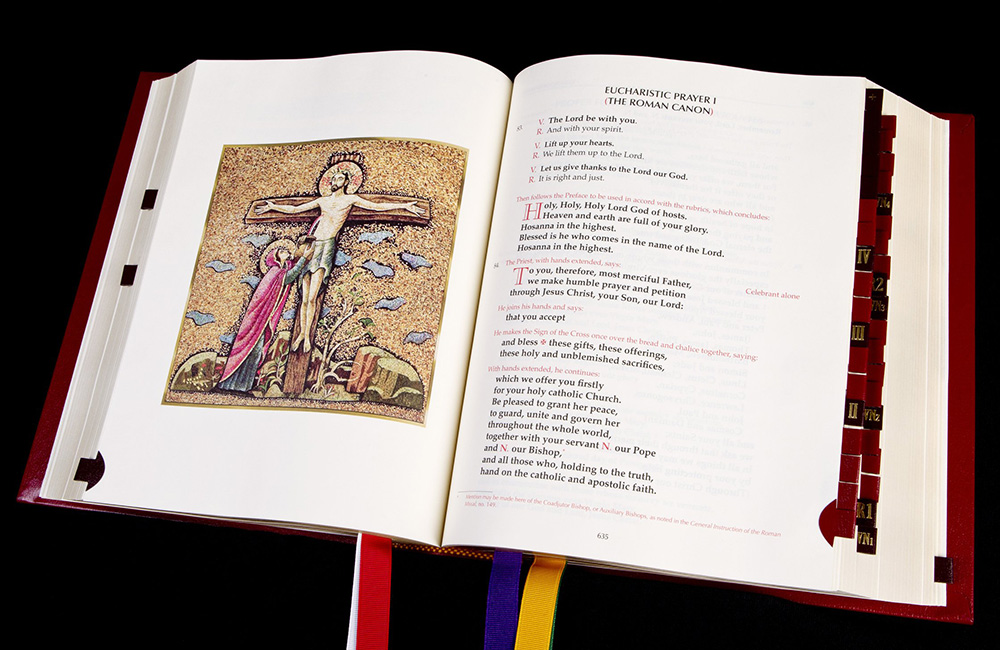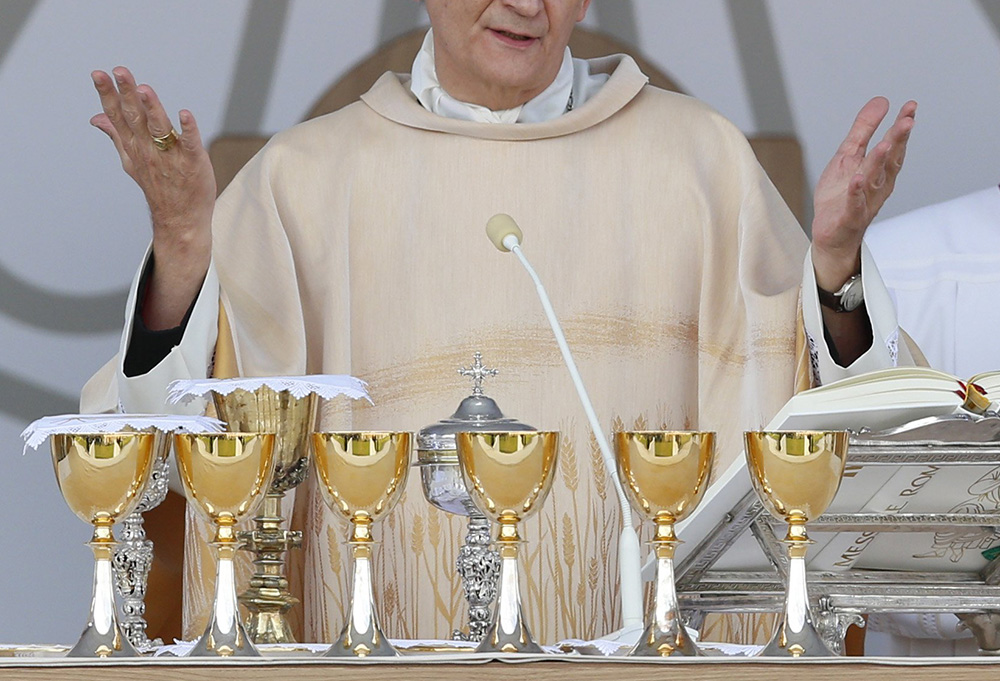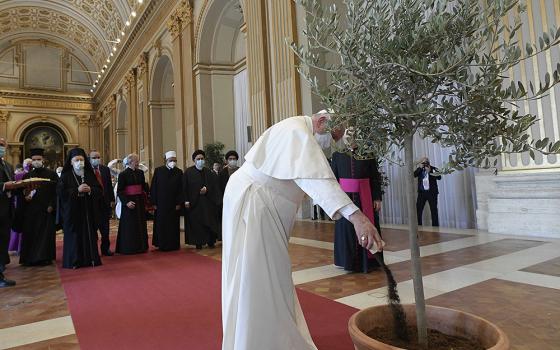
Fr. Patrick Ojiakor, a priest from the Diocese of Onitsha, Nigeria, raises the host during Mass Jan. 19, 2020, at a church in Central Islip, New York. (CNS/Gregory A. Shemitz)
The eucharistic prayer is the most important and least understood prayer in the Catholic Mass. Most Catholics see it as the priest's prayer that is centered on the consecration of the bread and wine into the body and blood of Christ.
Many priests use Eucharistic Prayer II, the shortest of the 13 versions of the prayer approved for use in the Catholic liturgy, and they recite it so quickly that if you blink you find yourself standing for the Lord's Prayer before you know it. Ironically, this prayer is attributed to Hippolytus, the first antipope, who opposed translating the Mass from Greek into the vulgar Latin.
In my column last week, I noted that the Liturgy of the Word was a Christian version of the synagogue service. To understand the Liturgy of the Eucharist, we need to realize that it is based on the Passover meal and other ritual meals like the Seder as celebrated by Jews.
At such meals, the father or head of the family says a prayer giving thanks and praise to God for his actions in the world on behalf of the people of Israel: for creation, for liberating his people from Egypt, for his covenant with Israel, for sending the prophets, etc.
When Jewish Christians gathered for a meal in memory of Jesus, they naturally prayed in the same way, except they also praised and thanked the Father for sending Jesus who taught, died and was raised for our salvation.
This is what we do in the eucharistic prayer. The word Eucharist comes from the Greek word for thanksgiving. The prayer begins with the exhortation: "Lift up your hearts. ... Let us give thanks to the Lord our God." The "Lord" in the eucharistic prayer is the Father.
The eucharistic prayer is addressed to the Father, not to Jesus. This is why the current acclamations addressed to Jesus after the consecration ("We proclaim your Death, Oh Lord, and profess your Resurrection until you come again.") are out of place. They are a hangover from seeing the Eucharist as a place to worship Jesus (about which, see the first column in this series, "The Eucharist is about more than the real presence").
If the eucharistic prayer is about Jesus, it is one that gives thanks and praise to the Father for all his actions in the world, but especially for sending his Son as our savior.
Remembering, thanking and praising goes from the beginning of the prayer all the way through the narrative drawn from the Last Supper and the recalling of the death, resurrection and enthronement of Jesus at the right hand of the Father.
Seen in this way, the institutional narrative (consecration) is not something dropped in the middle of some extraneous prayers, but is part of the history of God's action in the world for which we give thanks.
For the Jews, the Passover and Seder are not simply times to remember the past, but also sacrificial meals that reaffirm their acceptance of the same covenant that God offered to their ancestors. Through eating the sacrifice, the Jews were united with God, entered into communion with God and renewed their covenant commitment.
So, too, with Christians. The Eucharist, more than a thanksgiving for the past, unites us with the sacrifice of Christ and renews the covenant the Father offered us in Jesus. Remembering, thanking and praising of the Father in the eucharistic prayer is followed by uniting ourselves with Christ's offering to the Father.
Advertisement
The eucharistic prayer is sometimes referred to as the anaphora, which comes from the Greek anaphero, "I offer up."
The sacrificial nature of the Eucharist takes up only a few lines in the eucharistic prayers, which is why priests should say them slowly and reverently.
Eucharistic Prayer II says, "As we celebrate the memorial of his death and resurrection, we offer you, Lord, the Bread of Life and the chalice of salvation." (I am using the current church translations, which regrettably are poorly done.)
Likewise, Eucharistic Prayer III says, "We offer you in thanksgiving this holy and living sacrifice." And it continues, "Look, we pray, upon the oblation of your church ..."
Eucharistic Prayer IV: "We offer you his Body and Blood, the sacrifice acceptable to you which brings salvation to the whole world."
Eucharistic Prayer I, the old Roman canon, uses more flowery language: "We, your servants and your holy people, offer to your glorious majesty from the gifts that you have given us, this pure victim, this holy victim, this spotless victim, the holy Bread of eternal life and the chalice of everlasting salvation." It goes on with references to the sacrifices of Abel, Abraham and Melchizedek.

The first eucharistic prayer is seen on a page from a copy of the Roman Missal in English published by the U.S. Conference of Catholic Bishops. (CNS/Nancy Wiechec)
The two Eucharistic Prayers for Reconciliation emphasize the reconciliation that comes from the sacrifice and the four Eucharistic Prayers for Use in Masses for Various Needs makes explicit the Eucharist's connection to the sacrifice of Christ.
But the sacrifice is not just something of which we are to be passive observers. By receiving Communion, we are united with the sacrifice of Christ and transformed by his Spirit.
This next section of the eucharistic prayers is called by the Greek word Epiclesis, for the calling down of the Spirit on those who receive the body and blood of Christ.
All of the prayers following the Epiclesis are petitions for how we want the Spirit to transform us, the Christian people: that we might be united as one body, that we might continue the work of Christ in the world and that we might be worthy to join the saints in heaven.
There is an earlier Epiclesis before the institutional narrative, where the Spirit is called down upon the bread and wine. Some Christians, like Cyril of Jerusalem, believed this, not the consecration, changed the bread and wine into the body and blood of Christ. Others believed that the entire eucharistic prayer is consecratory.
Augustine and Thomas Aquinas popularized in the West the view that the bread and wine changed at the consecration. But there is a eucharistic prayer without a consecration used by the Assyrian Church of the East, which is recognized by Rome as valid.
According to the New Dictionary of Sacramental Worship, "New Lutheran, Episcopal, Methodist, and Presbyterian eucharistic prayers have opted for the West Syrian pattern of placing a Spirit-epiclesis after the words of institution. These epicleses typically do not ask the Holy Spirit to change the bread and wine, but they do connect the Spirit working through the gifts of communion to effect unity, forgiveness, life and salvation along the lines of the most primitive anaphora."
After giving so much attention to the offering, Eucharistic Prayer I gives little attention to the transforming impact of Communion, perhaps because for centuries few people went to Communion. Unlike the other eucharistic prayers, this prayer does not even mention the Spirit: "so that all of us, who through this participation at the altar receive the most holy Body and Blood of your Son, may be filled with every grace and heavenly blessing." Epiclesis may be implied but is not explicit.
In the other eucharistic prayers the Epiclesis is explicit, but brief. Again, priests need to recite these sections slowly so that people notice them.
In Eucharistic Prayer II, we pray that the Spirit gather us into one and help the church to "spread throughout the world" and experience "the fullness of charity."
Eucharistic Prayer III asks "that we, who are nourished by the Body and Blood of your Son and filled with his Holy Spirit, may become one body, one spirit in Christ."
Eucharistic Prayer IV prays, "Grant in your loving kindness to all who partake of this one Bread and one chalice that, gathered into one body by the Holy Spirit, they may truly become a living sacrifice in Christ to the praise of your glory."

A cardinal celebrates the Eucharist during Italy's National Eucharistic Congress at the municipal stadium in Matera, Italy, Sept. 25, 2022. (CNS/Paul Haring)
The two Eucharistic Prayers for Reconciliation give more stress to the role of the Holy Spirit in reconciliation.
The four Eucharistic Prayers for Uses in Masses for Various Needs also have an Epiclesis. My favorite is the third, which uses language from the Second Vatican Council to show how we want the Spirit to transform those who receive the Body of Christ:
Grant that all the faithful of the Church, looking into the signs of the times by the light of faith, may constantly devote themselves to the service of the Gospel. Keep us attentive to the needs of all that, sharing in their grief and pain, their joy and hope, we may faithfully bring them the good news of salvation and go forward with them along the way of your kingdom.
The eucharistic prayers conclude by returning to praise the Father through Jesus Christ, his Son. "Through him, and with him, and in him, O God, almighty Father, in the unity of the Holy Spirit, all glory and honor is yours, for ever and ever."
In short, in the eucharistic prayer, we give praise and thanks to God for his actions in the world, especially his sending of his Son. We unite ourselves with Christ's sacrifice in worshipping the Father. We ask for the Spirit to transform us into the body of Christ so that we can continue his mission in the world.
This is summed by liturgical scholars using the Greek terminology of eucharistia (thanking), anaphora (offering) and epiclesis (calling down the Spirit).
The eucharistic prayer tells us what the Eucharist is all about. It is giving thanks and praise to God; it is being united with the sacrifice of Christ for our salvation; and it is being transformed by the power of the Spirit so that we can continue his work in the world. This makes Communion not an individual devotion but the community's worship of the Father and a transformative experience that turns individuals into what we eat, the body of Christ.





